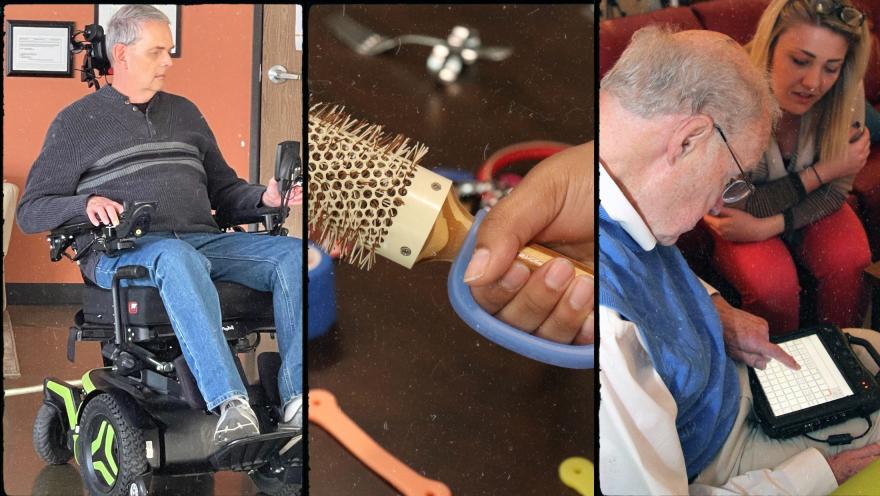Discovering and improving assistive technologies for people living with ALS is another important way we are working to make ALS livable for everyone, everywhere, until we can cure it.
The physical impact of living with the disease presents many challenges, especially as it progresses. Muscle weakness and issues with mobility, balance, flexibility, and communication can make everyday activities difficult or even impossible.
Since the Ice Bucket Challenge, advancements in assistive technology have significantly improved the quality of life for people living with ALS, helping them to communicate more effectively, maintain independence, and remain engaged in daily activities despite the challenges posed by the disease.
Why are assistive technologies important?
Dr. Dave explained, “In people with ALS, the disease progresses in such a way that the motor neurons that are in your body that control movement and mobility start to die off, and you start losing your ability to speak, to move, to breathe. And assistive technologies help people speak and move when their bodies can't. Those technologies are assisting people to do those normal things that they would do that the disease takes away from them.”

“Over the last 10 years, we have seen technologies that can retain speech or allow people to speak through a machine, or what the new state-of-the-art is in ALS is what we call brain-computer interface, or BCI devices,” Dr. Dave said. This technology records brain signals and then translates or decodes those brain signals to allow someone who is not able to move to control objects in their environment using their minds.
“And so, people who can't speak are able to speak by just thinking about it, or are able to type by just thinking about it. The last 10 years since the Ice Bucket Challenge have changed this brain-computer interface field, and it's really become the state-of-the-art,” he said.
According to Dr. Dave, another technology that has really gained prominence in the last five years is wheelchair seat elevation. When meeting people in wheelchairs, they're generally seated at a lower level, and like most people, want the opportunity to make eye contact.
“The technology has now developed where wheelchairs can have seat elevation, and because of the change, they're able to do things, not just speak to you at eye level, but maybe open a fridge that they couldn't before or open a cabinet that they couldn't before. And these are the type of technologies that normally don't get a lot of highlighting but are really important to manage ALS.”
The ALS Association has been funding the development of assistive technologies for more than the last 10 years. “However, this year, we did a concerted effort on developing a brand-new assistive technology program,” he shared.
Similar to how new drugs must go through a series of clinical trials, assistive technologies need to complete several stages of development before they are made widely available “because you are trying to understand: Does this technology work in ALS? Will it actually have an impact?”
Our Assistive Technology Grant Program supports early-stage technology development and validation. “The idea is that if we can validate that this technology works in ALS, we can then hopefully have larger technology companies come in and take that technology forward.”
“Through the program, we identified six new technologies that we have funded, and we have committed $3 million to those six technologies. They're in early stage, so we don't know how they'll turn out, but we really hope that they become the next brain-computer interface and seat elevation-type technology of tomorrow,” he said.
One of the projects, for example, is looking at artificial intelligence, or AI, and how a machine will direct a wheelchair into different rooms so that when a wheelchair is in the kitchen, it moves differently than when it's in the family room.
“These things are not trivial because for a person living with ALS who's not able to move, if the wheelchair can think how the wheelchair has to move in a particular space because of the environment it is in, that takes the burden off of the person living with ALS.”
“And that's why this program is really crucial. The eventual goal is that these technologies will help people with ALS move better, speak better, breathe better, and manage ALS better.”
We still need more assistive technology.
We still need a cure.
Let’s see it end.
The Future of Assistive Technology
Corporations and academic institutions are finding new ways to leverage recent technological advances to empower people with ALS to live their lives to the fullest.
At ALS Nexus, leaders in the field will explore the future of assistive technology and discuss how to ensure people living with ALS can access these devices.
Be a part of the conversation. Join us at ALS Nexus.
To learn more about the latest updates in ALS research, subscribe to our monthly e-newsletter, Research Matters.
To continue to follow stories about people living with ALS in the community and learn more about the disease, subscribe to receive our weekly blogs in your inbox HERE or follow us at als.org/blog.


Join the conversation. Please comment below.